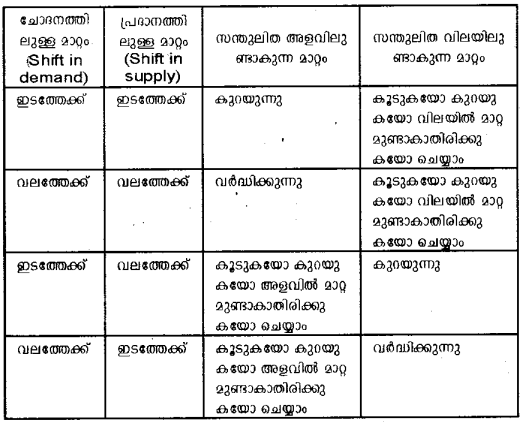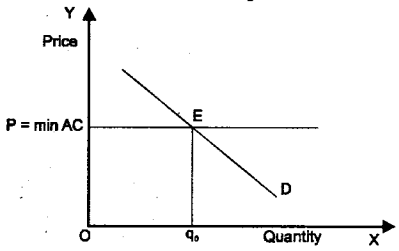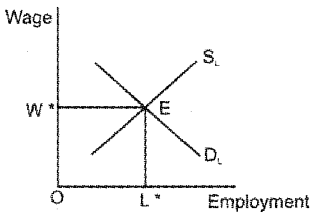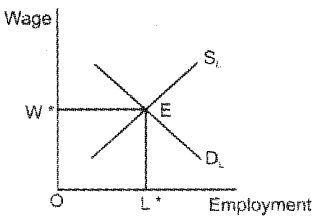Kerala Plus Two Microeconomics Notes Chapter 5 Market Equilibrium
Equilibrium
Equilibrium is a situation where two opposing forces balance. Market equilibrium is defined as a situation where the plans of all consumers and firms in the market match and the market class. It is the point where market supply equals market demand. The price at which equilibrium is reached is called equilibrium price and the quantity bought and sold at this price is called equilibrium quantity Qd = Qs
സന്തുലിതാവസ്ഥ
രണ്ട് എതിർശക്തികൾ തുല്യമായ അവസ്ഥയെ സന്തുലിതാവസ്ഥ എന്ന് പറയുന്നു. കമ്പോള സന്തുലിതാവസ്ഥ എന്നത് എല്ലാ ഉപ ഭോക്താക്കളുടെയും ഉല്പാദന യൂണിറ്റുകളുടെയും പദ്ധതികൾ ഒത്തുപോകുന്ന അവസ്ഥയാണ്. കമ്പോള ചോദനവും കമ്പോള പ്രദാനവും തുല്യമാകുന്ന അവസ്ഥയാണിത്. കമ്പോളം ഏത് വില യിലാണോ സന്തുലിതമാകുന്നത് അതിനെ സന്തുലിത വില യെന്നും ആ വിലയ്ക്ക് വിറ്റഴിക്കപ്പെടുന്ന സാധനങ്ങളുടെ അള വിനെ സന്തുലിത അളവ് എന്നും പറയുന്നു.
Qd = Qട
Excess Demand And Excess Supply
At a particular price, when the quantity demanded is greater than the quantity supplied, is a case of excess demand.
i.e. qd > qs
At a particular price, when the quantity supplied is greater than the quantity demanded is a case of excess supply.
അധികചോദനം
ഒരു നിശ്ചിത വിലയിൽ കമ്പോള ചോദനത്തിന്റെ അളവ് കമ്പോള പ്രദാനത്തിന്റെ അളവിനേക്കാൾ കൂടുതലായ അവസ്ഥയെ അധി കചോദനം എന്നുപറയുന്നു. ചോദനം qd യും പ്രദാനം qs ഉം ആയാൽ അധിക ചോദനം qd > qs ആയിരിക്കും.
അധികപ്രദാനം
ഒരു നിശ്ചിത വിലയിൽ കമ്പോളപ്രദാനത്തിന്റെ അളവ് കമ്പോള ചോദനത്തേക്കാൾ കൂടുതലായ അവസ്ഥയെ അധിക്രപദാനം എന്നുപറയുന്നു. ഇവിടെ qs > qd ആണ് അധിക പ്രദാനം.
Market Equilibrium: Fixed Number of Firms
The number of firms in a market is an important factor influencing the market equilibrium. The number of firms in a market could be fixed or variable. The following section examines the equilibrium situation in a market when the number of firms are fixed. In such a market, the equilibrium is attained through the interaction of demand and supply. When price increases, the demand falls. On the other hand, when price rises, the demand falls. It can be explained with the help of diagram given below.
In the diagram, SS is the market supply curve and DD is the market demand curve. The supply curve shows the quantity that all the producers in the market are willing to sell at different prices. The demand curve indicates the quantity that all the consumers in the market are willing to buy at different prices.
കമ്പോള സംതുലിതാവസ്ഥ: ഉല്പാദക യൂണിറ്റുകളുടെ എണ്ണം സ്ഥിരമായിരിക്കുമ്പോൾ
ഒരു കമ്പോളത്തിലുള്ള ഉല്പാദക യൂണിറ്റുകളുടെ എണ്ണം കമ്പോള സന്തുലിതാവസ്ഥയെ സ്വാധീനിക്കുന്ന ഒരു പ്രധാന ഘട കമാണ്. കമ്പോളത്തിലെ ഉല്പാദക യൂണിറ്റുകളുടെ എണ്ണം സ്ഥി രമോ അസ്ഥിരമോ ആകാം. ഉല്പാദക യൂണിറ്റുകളുടെ എണ്ണം സ്ഥിരമായിരിക്കുമ്പോൾ കമ്പോള സന്തുലിതാവസ്ഥ നിർണ്ണയി ക്കപ്പെടുന്നത് എങ്ങനെയാണെന്ന് നോക്കാം.
ഒരു കമ്പോളത്തിലെ സ്ഥാപനങ്ങളുടെ എണ്ണം സ്ഥിരമായിരു ന്നാൽ ചോദന – പ്രദാന ശക്തികളുടെ പ്രവർത്തനഫലമായി കമ്പോളം സന്തുലിതാവസ്ഥ കൈവരിക്കുന്നു. അതായത് വില വർധിക്കുമ്പോൾ ചോദനം കുറയുകയും വില കുറയുമ്പോൾ ചോദനം കൂടുകയും ചെയ്യുന്നു. അതുപോലെ വില വർദ്ധിക്കു മ്പോൾ പ്രദാനം വർദ്ധിക്കുകയും വില കുറയുമ്പോൾ പ്രദാനം കുറയുകയും ചെയ്യുന്നു. ഇത് ഒരു ഡയഗ്രത്തിലൂടെ നോക്കാം. താഴെ കൊടുത്തിരിക്കുന്ന ഡയഗ്രം ഒരു പൂർണ്ണമത്സര കമ്പോള ത്തിലെ ഉല്പാദക യൂണിറ്റുകളുടെ എണ്ണം സ്ഥിരമായിരിക്കുമ്പോ ഴുള്ള സന്തുലിതാവസ്ഥ കാണിക്കുന്നു. ഡയഗത്തിലെ SS കമ്പോള പ്രദാനവകവും, DD കമ്പോള പ്രചോദനവകവുമാണ്. വിവിധ വിലകളിൽ ഉല്പാദകർ വിൽക്കാൻ ആഗ്രഹിക്കുന്ന സാധ നത്തിന്റെ അളവിനെ SS എന്ന കമ്പോളപ്രദാനവകം കാണിക്കു ന്നു. വിവിധ വിലകളിൽ ഉപഭോക്താക്കൾ വാങ്ങാൻ ആഗ്രഹി ക്കുന്ന സാധനത്തിന്റെ അളവിനെ DD എന്ന കമ്പോള ചോദന വകം സൂചിപ്പിക്കുന്നു.

Calculating equilibrium quantity and price with demand and supply function From the given market demand and supply function it is possible to calculate equilibrium price and quantity.
e.g. qD = 200 – P for 0 ≤ P ≤ 200
= 0 for P > 200
qs = 120 + P for P ≥ 10
= 0 for 0 ≤ P < 10
The equation says that the demand functions is valid only for a price between 0 and 200 and quantity demand will be zero if the price is above 200. Supply function is valid only if the price is greater than or equal to 10 and supply would be zero if the price is in between zero and 10.
For solving the equations, the condition for market equilibrium is
Qd = Qs
that is 200 – P = 120 + P
bringing the similar items together we get,
200 – 100 = P + P
80 = 2P
P = 80/2 = 40
Therefore the market price is 40
Substituting the market price in any of the above equation, we get the equilibrium quantity
i.e, Qd = 200 – P
= 200 – 40 = 160
or
Qs = 120 + P
= 120 + 40 = 160
So the equilibrium price is 40 and equilibrium quantity is 160.
ചോദന പ്രദാന ധർമ്മങ്ങൾ ഉപയോഗിച്ച് സന്തുലിത വിലയും അളവും കണക്കാക്കുന്ന രീതി.
ചോദന പ്രദാന ധർമ്മങ്ങളിൽനിന്നും സന്തുലിത വില, അളവ് എന്നിവ കണക്കാക്കാവുന്നതാണ്. ഉദാഹരണം,
qD = 200 – P for 0 ≤ P ≤ 200
= 0 for P > 200
qS = 120 + P for P ≥ 10
= 0 for 0 ≤ P < 10
ഇവിടെ ചോദന ധർമ്മം നിലനിൽക്കണമെങ്കിൽ വില പൂജ്യത്തിനും 200നും ഇട യിലാകണം. വില 200 ൽ കൂടുതലാണെങ്കിൽ ചോദനം പൂജ്യമാകും.
പ്രദാന ധർമ്മം നിലനിൽക്കണമെങ്കിൽ വില പത്തോ അധിലധി കമോ ആകണം. വില പൂജ്യത്തിനും പത്തിനും ഇടയിലാകണ മെങ്കിൽ പ്രദാനം പൂജ്യമായിരിക്കണം. കമ്പോള സന്തുലിതാവസ്ഥയ്ക്ക്
Qd = Qട
അതായത് 200 – P = 120 + P
ഒരേപോലെയുള്ള ഇനങ്ങളെ ഒരുമിച്ച് കൊണ്ടുവരുമ്പോൾ
200 – 120 = P + P
80 = 2P
P = 80/2 = 40
കമ്പോള വില 40 ആണ്. ഈ കമ്പോള വില മുകളിലെ ഏതെ ങ്കിലും ഒരു സമവാക്യത്തിൽ കൊടുത്താൽ സന്തുലിത അളവ് ലഭിക്കും.
അതായത്
Qd = 200 – P
= 200 – 40 = 160
or
Qs = 120 + P
= 120 + 40 = 160
അതായത് കമ്പോള വില 40 ഉം സന്തുലിത അളവ് 160 ഉം ആണ്.
Change in Equilibrium Due to Change in Demand and Supply
So far the market equilibrium condition was based on the assumption that all factors other than price remain constant in demand and supply analysis. It means that taste and preference of the consumer, prices of related goods, income of the consumer, technology, size of the market, prices of factors of production, etc. remains constant. When these factors change, there would be a shift in either demand curve or supply curvs or both. It is likely to affect the equilibrium price and equilibrium quantity.
ചോദനത്തിലും പ്രചോദനത്തിലും ഉണ്ടാകുന്ന മാറ്റം മൂലം സന്തു ലിതാവസ്ഥയിൽ ഉണ്ടാകുന്ന മാറ്റം
അഭിരുചി, മറ്റ് സാധനങ്ങളുടെ വില, ഉപഭോക്താവിന്റെ വരുമാനം, സാങ്കേതികവിദ്യ, കമ്പോളത്തിന്റെ വലിപ്പം, ഉല്പാദനത്തിൽ ഉപ് യോഗിക്കുന്ന നിവേശങ്ങളുടെ വില തുടങ്ങിയവ സ്ഥിരമാണെന്ന സങ്കൽപ്പത്തിലാണ് നാം ഇതുവരെ സന്തുലിതാവസ്ഥയെക്കുറിച്ച് പഠിച്ചത്. ഈ ഘടകങ്ങളിൽ മാറ്റമുണ്ടായാൽ ചോദനവകത്തിലോ പ്രദാനവകത്തിലോ ഇവ രണ്ടിലുമോ മാറ്റം സംഭവിക്കാം. ഇത് സന്തുലിത വിലയേയും അളവിനേയും ബാധിക്കും.
Effects Of Shift in Demand and Supply

ചോദനത്തിലും പ്രചോദനത്തിലും ഉണ്ടാകുന്ന മാറ്റം
ചോദനവകം ഇടത്തോട്ട് → വില കുറയും, അളവ് കുറയും
ചോദനവകം വലത്തേക്ക് → വില കൂടും, അളവ് കുടും
പ്രദാനവകം ഇടത്തോട്ട് → വില കൂടും, അളവ് കുറയും
പ്രദാനവകം വലത്തേക്ക് → വില കുറയും, അളവ് കുടും
Simultaneous Shifts in Demand and Supply

ചോദനം, പ്രദാനം എന്നിവയിൽ ഒരേ സമയമുണ്ടാകുന്ന മാറ്റം

Market Equilibrium – Free Entry and Exit
In a market characterized by free entry and exit, the equilibrium price would be equal to the minimum point of Average Cost. Since there is freedom of entry and exit of the firms, the supply curve would be perfectly elastic. Thus, under perfect competition, the market price would be the equal to the minimum of Average Cost (AC. This is demonstrated with the help of following figure.
Equilibrium when free entry and exit allowed:

In the above figure, the demand curve DD intersects at point E, where the market price is equal to the minimum of Average Cost. At this point of equilibrium, P0 is the equilibrium price and q, is the market equilibrium quantity. P0 is equal to the minimum of Average Cost. It indicates that at price P0, the quantity demanded would be equal to the quantity supplied.
The number of films under equilibrium n0 = \(\frac{q_{0}}{q_{f}}\). Here q0 is the market equilibrium quantity and qf is the supply of the firm.
കമ്പോള സന്തുലിതാവസ്ഥ – പൂർണ പ്രവേശന – നിർഗമന സ്വാതന്ത്ര്യം ഉളളപ്പോൾ
പൂർണ പ്രവേശന- നിർഗമന സ്വാതന്ത്യം ഉളളപ്പോൾ സന്തുലിത വിലയെന്നത് AC-യുടെ മിനിമം ബിന്ദുവിന് തുല്യമായിരിക്കും. അതായത് P = ACയുടെ മിനിമം.
ഈ അവസ്ഥയിൽ പ്രദാനം പൂർണ ഇലാസ്തികമായിരിക്കും. അതിനാൽ, പൂർ ണ മത്സര കമ്പോളത്തിലെ കമ്പോള വില എപ്പോഴും ശരാശരി ചെലവിന്റെ (AC) മിനിമം ആയിരിക്കും.

ചിത്രത്തിൽ DD എന്ന ചോദനവകം P = min AC രേഖയിൽ E എന്ന ബിന്ദുവിൽ സംഗമിക്കുന്നു. ഈ സന്തുലിതാവസ്ഥയിൽ P0 എന്നത് സന്തുലിത വിലയും, q0 എന്നത് സന്തുലിത അളവു മാണ്. P0 എന്ന വില AC-യുടെ മിനിമത്തിന് തുല്യമാണ്. അതാ യത് P0 വിലയിൽ മൊത്തം പ്രദാനവും, മൊത്തം ചോദനവും തുല്യമാണ്. (q0)
സന്തുലിതാവസ്ഥയിലെ ഉല്പ്പാദന യൂണിറ്റുകളുടെ എണ്ണം (n0)
(n0) = \(\frac{q_{0}}{q_{f}}\) ആയിരിക്കും.
Applications of Market Price
Price ceiling and price floor are the two types of government interventions in market.
1) Price ceiling:
In this case, government fixes a maximum allowable price for certain goods. The government imposed upper limit on the price of a good or service is called-price ceiling. Price ceiling is generally imposed on necessary items like wheat, rice, kerosene, sugar and it is fixed below the market-determined price since at the market determined price some section of the population will not be able to afford these goods.
2) Price Floor:
For certain goods and services, fall in price below a particular level is not desirable and hence the government sets floors or minimum prices for these goods and services. The government imposed lower limit on the price that may be charged for a particular good or service is called price floor.
Through the minimum wage legislation, the government ensures that the wage rate of the labourers does not fall below a particular level and here again the minimum wage rate is set above the equilibrium wage rate.
കമ്പോള വിലയിലെ ഇടപെടൽ – പ്രായോഗിക നടപടി
കമ്പോള വിലയിലുള്ള ഗവൺമെന്റിന്റെ ഇടപെടലാണ് വില പരി ധിയും തറവിലയും.
1. വിലപരിധി:
സാധനങ്ങൾക്കും, സേവനങ്ങൾക്കും ഗവൺമെന്റ് നിശ്ചയി ക്കുന്ന പരമാവധി വിലയാണ് വില പരിധി (Price Ceiling). ഉപഭോക്താക്കളുടെ താൽപര്യം സംരക്ഷിക്കാൻ വേണ്ടിയാണ് ഗവൺമെന്റ് ഇത്തരത്തിൽ ഇടപെടുന്നത്. ചോദന-പദാന ശക്തികളുടെ പ്രവർത്തനത്തിലൂടെ നിർണയിക്കുന്ന സന്തു ലിത വിലയേക്കാൾ കുറവായിരിക്കും വില പരിധി (Price Ceiling). അത്യാവശ്യ സാധനങ്ങളായ (essential goods) അരി, ഗോതമ്പ്, മണ്ണെണ്ണ, പഞ്ചസാര തുടങ്ങിയ സാധനങ്ങൾ ക്കാണ് സാധാരണയായി വിലപരിധി ഏർപ്പെടുത്തുന്നത്.
2. തറവില:
സാധനങ്ങൾക്കും, സേവനങ്ങൾക്കും ഗവൺമെന്റ് നിശ്ചയി ക്കുന്ന മിനിമം വിലയാണ് തറവില അഥവാ താങ്ങുവില (support price). ഉല്പാദകരുടെ താൽപര്യം സംരക്ഷിക്കാൻ വേണ്ടിയാണ് ഗവൺമെന്റ് ഇത്തരത്തിൽ ഇടപെടുന്നത്. കമ്പോളത്തിൽ ചോദന – പ്രദാന പ്രവർത്തനങ്ങളുടെ ഫല മായി ഉണ്ടാകുന്ന സന്തുലിത വിലയേക്കാൾ ഉയർന്ന വില യാണ് തറവില (Price floor). കമ്പോള സന്തുലിത വില വളരെ താഴ്ന്നതാകുമ്പോൾ ഉല്പാദകർക്ക് നഷ്ടമുണ്ടാകു ന്നു. ഈ അവസരത്തിൽ ഗവൺമെന്റ് കമ്പോളത്തിൽ ഇടപെ ടുകയും സാധനങ്ങൾക്ക് തറവില (Price Floor) പ്രഖ്യാപി ക്കുകയും ചെയ്യുന്നു.
Wage Determination in Labour Market
The basic difference between a labour market and a market for goods is with respect to the source of supply and demand. In the labour market, households are the suppliers of labour and the demand for labour comes from firms whereas in the market for goods, it is the opposite. The wage rate is determined at the intersection of the demand and supply curves of labour where the demand for and supply of labour balance.
The firm being a profit maximiser will always employ labour up to the point where the extra cost she incurs for employing the last unit of labour is equal to the additional benefit she earns from that unit. The extra cost of hiring one more unit of labour is the wage rate (w). The extra output produced by one more unit of labour is its marginal product (MPL) and by selling each extra unit of output, the additional earning of the firm is the marginal revenue (MR) she gets from that unit. Therefore, for each extra unit of labour, she gets an additional benefit equal to marginal revenue times marginal product which is called Marginal Revenue Product of Labour (MRPL). Thus, while hiring labour, the firm employs labour up to the point where w = MRPL and MRPL = MR x MPL
Since we are dealing with a perfectly competitive firm, marginal revenue is equal to the price of the commodity and hence marginal revenue product of labour in this case is equal to the value of marginal product of labour (VMPL).
As long as the VMPL is greater than the wage rate, the firm will earn more profit by hiring one more unit of labour, and if at any level of labour employment VMPL is less than the wage rate, the firm can increase her profit by reducing a unit of labour employed.

തൊഴിൽ കമ്പോളത്തിൽ വേതന നിർണ്ണയം
ഉൽപ്പന്ന കമ്പോളത്തിൽ ചോദന പ്രദാന ശക്തികൾ ചേർന്നാണ് സാധനങ്ങളുടെ വില നിശ്ചയിക്കുന്നത്. ഇതുപോലെയാണ് തൊഴിൽ കമ്പോളത്തിലും ചോദന പ്രദാന ശക്തികൾ ചേർന്നാണ് വേതനം നിർണയിക്കുന്നത്.
ഉൽപ്പന്ന കമ്പോളവും തൊഴിൽ കമ്പോളവും തമ്മിൽ സുപ്രധാ നമായൊരു വ്യത്യാസമുണ്ട്. ചരക്കുകളുടെ കാര്യത്തിൽ ചോദനം ഉണ്ടാകുന്നത് ഉപഭോക്താക്കളിൽ നിന്നും പ്രദാനം ഉണ്ടാകുന്നത് സ്ഥാപനങ്ങളിൽ നിന്നുമായിരിക്കും. എന്നാൽ തൊഴിലിന്റെ കാര്യ ത്തിൽ ചോദനം ഉണ്ടാകുന്നത് സ്ഥാപനങ്ങളിൽ നിന്നും, പ്രദാന മുണ്ടാകുന്നത് ഗാർഹിക യൂണിറ്റുകളിൽ നിന്നുമാണ്. അതു പോലെ ഒരു സാധനത്തിന്റെ ചോദനം നേരിട്ടുള്ളതാണ് (Direct Demand). എന്നാൽ തൊഴിലിനുവേണ്ടിയുള്ളതും ഉല്പാദന ഘടകങ്ങൾക്ക് വേണ്ടിയുള്ളതുമായ ചോദനം ഉരുത്തിരിഞ്ഞു വരുന്നവയാണ് . (Derived Demand).
സീമാന്ത ഭൗതിക ഉല്പന്നം (MPPL)
ഒരു അധിക യൂണിറ്റ് തൊഴിൽ ശക്തി കൂടി ഉപയോഗിക്കുമ്പോൾ സ്ഥാപനത്തിന് ലഭിക്കുന്ന അധിക ഉൽപന്നമാണ് സീമാന്തഭൗതിക ഉല്പന്നം (MPPL)
MPPL = TPPL – TPPL = 1
സീമാന്ത വരുമാന ഉല്പന്നം (MRPL)
ഒരു അധിക യൂണിറ്റ് തൊഴിൽ ശക്തി ഉപയോഗിക്കുമ്പോൾ അധി കമായി ലഭിച്ച ഉല്പന്നം വിറ്റുകിട്ടുന്ന അധികവരുമാനത്തെ സീമാന്ത വരുമാന ഉല്പന്നം (MRPL) എന്നുവിളിക്കുന്നു.
MRPL = TRPL – TRPL = 1
തൊഴിലിന്റെ സീമാന്ത ഉല്പന്ന മൂല്യം (VMPL)
ഒരു അധിക യൂണിറ്റ് തൊഴിൽ ശക്തി കൂടി ഉപയോഗിക്കുമ്പോൾ മൊത്തം ഉല്പന്നത്തിലുണ്ടാകുന്ന മാറ്റത്തിന്റെ (MPPL) പണമു ല്യത്തെ തൊഴിലിന്റെ സീമാന്ത ഉല്പന്നമൂല്യം (VMPL) എന്നുപറ യുന്നു.
VMPL = MMPL × ഉല്പന്നത്തിന്റെ വില
ഒരു പൂർണ മത്സര കമ്പോളത്തിൽ ഉല്പന്നത്തിന്റെ വില സ്ഥിര മായതുകൊണ്ട് MRPL = VMPL ആയിരിക്കും.
തൊഴിലിന്റെ സീമാന്ത വരുമാന ഉല്പന്നം വേതനത്തിന് തുല്യമാ കുന്നതുവരെ ഒരു സ്ഥാപനം തൊഴിൽ ശക്തി ചോദനം ചെയ്യും. ആയതിനാൽ

Applications
We will analyze these issues within the framework of perfect competition to look at what impact these regulations have on the market for these goods. Price Ceiling: In this case, government fixes a maximum allowable price for certain goods. The government-imposed upper limit on the price of a good or service is called price ceiling. Price ceiling is generally imposed on necessary items like wheat, rice, kerosene. sugar and it is fixed below the marketdetermined price since at the market-determined price some section of the population will not be able to afford these goods.
Price Floor: For certain goods and services, fall in price below a particular level is not desirable and hence the government sets floors or minimum prices for these goods and services. The goverment imposed lower limit on the price that may be charged for a particular good or service is called price floor.
Through the minimum wage legislation, the govemment ensures that the wage rate of the labourers does not fall below a particular level and here again the minimum wage rate is set above the equilibrium wage rate.
